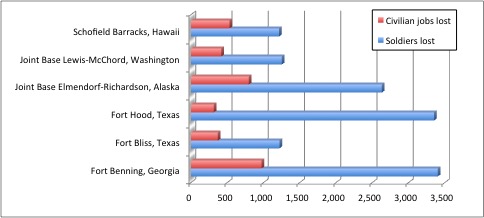Army Bases Bleed, Then BRAC Comes
http://breakingdefense.com/2015/10/army-bases-bleed-then-brac-comes/

Army Bases Bleed, Then BRAC Comes
By Sydney J. Freedberg Jr. on October 21, 2015 at 12:52 PM
WASHINGTON: Congress hates base closures, known as BRAC. But it turns out you don’t need a Base Realignment And Closure round to hurt homestate economies. If you cut the Army by 120,000 (from a wartime peak of 570,000 to 450,000), and prohibit the Pentagon from closing bases, what you get — instead of wholesale shutdowns — is the death of a thousand cuts. Eventually, as the pressure builds, you probably end up with a BRAC anyway.
That’s the lesson our sources extract from the Army Secretary‘s official report to Congress on the most recent round of cuts, the 40,000-soldier reduction detailed in July. (The Federation of American Scientists just posted a FOIA’d copy online, but we got the report a few days ago and had time to pass it around to experts). Amidst the process details and boilerplate, the 22-page document enumerates some of the economic impacts of the cuts: an estimated $828 million in losses and 3,401 lost local jobs.

We say some of the consequences because the Army report is incomplete as it only covers the six bases that were hardest hit, specifically the ones losing more than 1,000 servicemembers, the legal threshold requiring a report: Fort Benning, Ga..; Fort Bliss and Fort Hood, Texas; Joint Base Elmendorf-Richardson, Alaska; Joint Base Lewis-McCord, Wa.; and Schofield Barracks, Hawaii.
The report also only covers the immediate impact to private sector jobs near the base. It’s silent on federal contractors. It doesn’t specify how many federal civilian employees will lose their jobs, but with fewer uniformed servicemembers to support, the civil service will take a hit as well. “Information on the number of employees affected at the installations listed in this report is not yet finalized,” the report said, “but total Army-wide civilian reductions through FY19 are expected to be ~17,000.” (Yes, that’s 17 thousand).

